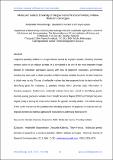| dc.contributor.author | Mwamahonje, Andekelile | |
| dc.contributor.author | Kilambo, Deusdedit | |
| dc.contributor.author | Feyissa, Tileye | |
| dc.date.accessioned | 2019-05-22T10:52:46Z | |
| dc.date.available | 2019-05-22T10:52:46Z | |
| dc.date.issued | 2015 | |
| dc.identifier.issn | 2325-4076 | |
| dc.identifier.uri | http://dspace.nm-aist.ac.tz/handle/123456789/153 | |
| dc.description | Research Article published by American Journal of Research Communication Vol 3(8), 2015 | en_US |
| dc.description.abstract | Grapevine powdery mildew is a fungal disease caused by Erysiphe necator (formerly Uncinula necator) which is an obligate parasite. It is considered to be one of the most important fungal diseases in viticulture worldwide causing 20% loss of grapevine production. Conventional breeding has been used to obtain powdery mildew resistant varieties however; it takes long time to obtain new variety. The use of molecular markers has been proposed to be the best method for identifying genes for resistance to powdery mildew which provides basic information in breeding programs. Furthermore, molecular markers have been useful in identifying genetic diversity among grapevine varieties. Inter Simple Sequence Repeat (ISSR) and Simple Sequence Repeat (SSR) is among the most useful markers for genetic diversity studies. This will be among of the useful markers as the guidelines for breeding programs of grapevine in tropical and sub-tropical countries to improve agricultural production in addressing food security. | en_US |
| dc.language.iso | en_US | en_US |
| dc.publisher | American Journal of Research Communication | en_US |
| dc.subject | Genetic diversity | en_US |
| dc.subject | Molecular marker | en_US |
| dc.subject | Powdery mildew | en_US |
| dc.title | Molecular Genetic Diversity of Grapevines to Produce Powdery mildew Resistant Genotypes | en_US |
| dc.type | Article | en_US |

